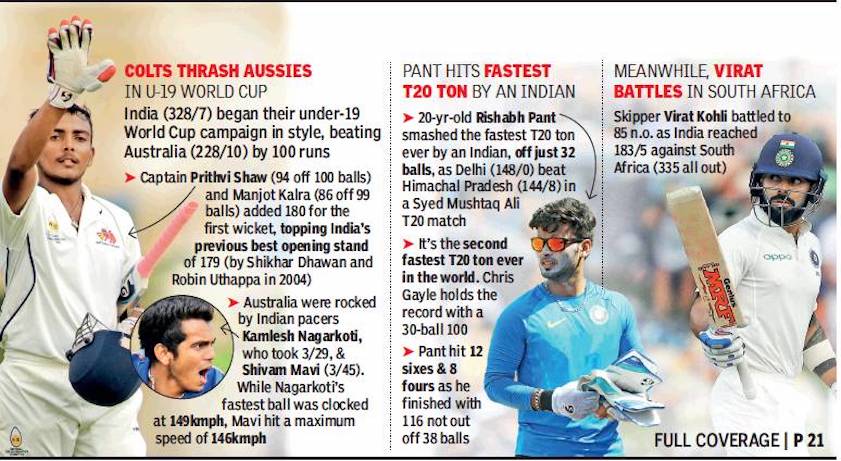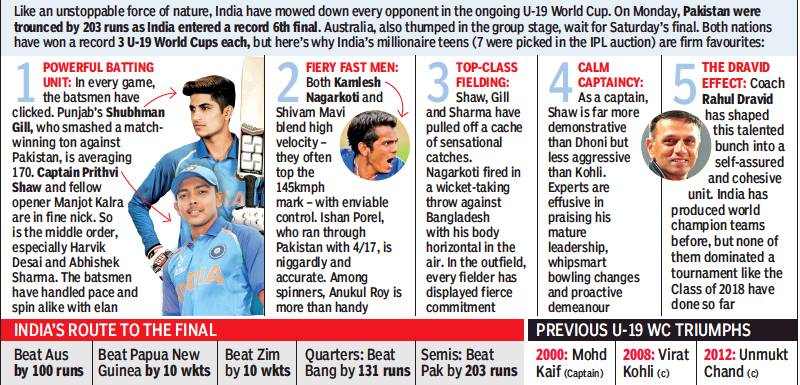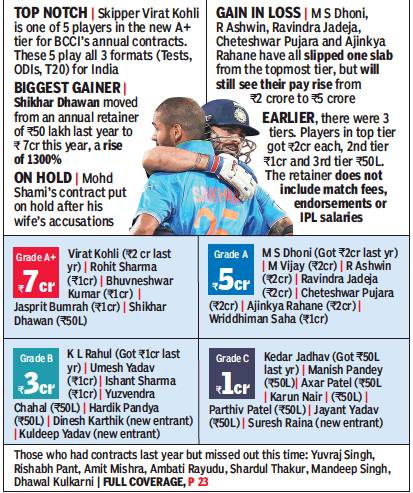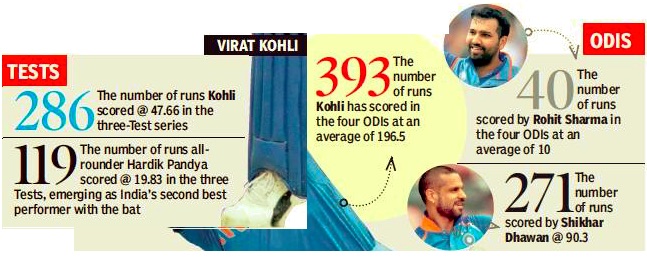Cricket, India: A history (2018)
This is a collection of articles archived for the excellence of their content. |
Contents |
U-19 World Cup
India beats Australia

In domestic cricket Rishabh Pant scored the fastest century by an Indian
From: January 15, 2018: The Times of India
See graphic:
India beat Australia in U-19 World Cup
In domestic cricket Rishabh Pant scored the fastest century by an Indian
How the Indians reached the finals

From January 31, 2018: The Times of India
See graphic:
The Indian U-19 team’s journey to the World Cup finals
India’s key players
February 3, 2018: The Times of India
KEY PLAYERS FOR INDIA
PRITHVI SHAW
The Mumbai lad shot into prominence as a 14-year old when he smashed 546 off 330 balls in an inter-school match In September last year, at 17, Shaw became the youngest to score a century on Duleep Trophy debut, a record previously held by Sachin Tendulkar. The captain of India’s U-19 team, Shaw has been consistent as an opener and has led the side with maturity and balance. During the tournament, he was bought by Delhi Daredevils for Rs 1.2 crore at the IPL auction. Took two fine catches at gully during the semis against Pakistan.
Matches: 5, Runs: 232, HS: 94, Avg: 77.33, SR: 98.72.
SHUBMAN GILL
With 341 runs under his belt in five games, this Punjab batsman has been the topscorer for India in this World Cup. He has an uncanny similarity with India captain Virat Kohli in the way he plays his shots. Gill, who belongs to Chak Khere Wala village in Punjab’s Fazilka district, started wielding the willow at the age of four. His father Lakhwinder is a farmer and land owner. Shubman was picked by Kolkata Knight Riders for a handsome Rs 1.8 crore in the IPL auction last Saturday. A consistently high-scorer in domestic age-group cricket, Gill will be a thorn in Australia’s side if he stays at the wicket for a while.
Matches: 5, Runs: 341, HS: 102*, Avg: 170.50, SR: 113.28.
KAMLESH NAGARKOTI
The speed-guns in New Zealand have been clocking Nagarkoti consistently at 145 plus, which is unheard of at this level. Nagarkoti has been one of the most talked-about teenagers in New Zealand over the last two weeks, with everyone from Ian Bishop to Sourav Ganguly raving about his raw pace, athleticism and attitude. The wiry right-arm pacer became the most expensive buy in the current U-19 team when he was bought by KKR in the 2018 IPL auction for Rs 3.2 crore. The Rajasthan pacer’s father was a subedar in the Indian Army who spent his retirement corpus to buy a one-bedroom apartment in Jaipur so his son could learn to play cricket.
Matches: 5, Wickets: 7, Best Bowling: 3-18, Avg: 15.14, Eco: 3.19
SHIVAM MAVI
Like his pace colleague Nagarkoti, Mavi caught the cricketing world’s attention when one of his deliveries touched 146kph on the speed gun, in India’s opening match against Australia. Has flattened the stumps of many batsmen, especially with the older ball, with his deadly yorker. Apparently, much like his idol, South African pace ace Dale Steyn, the lad from Noida hates being hit even in the nets. Interestingly, Mavi comes from an area near Meerut which is known to produce swing bowlers rather than genuine quicks.
Switched to Uttar Pradesh after being rejected by Delhi for their U-16 team.
Matches: 5, Wickets: 8, Best Bowling: 3-45, Avg: 15.50, Eco: 3.77.
ANUKUL ROY
This left-arm spinner hails from Samastipur, a small town in northern Bihar. After playing tennisball tournaments there, he moved to Jamshedpur in pursuit of serious cricket. Interestingly, he came into the World Cup straight out of legnthy period of injury rehabilitation. He bowled for hours together at India’s pre-tournament camp in Bengaluru. In a side packed with spinners (there are four others capable of bowling 10 overs), Roy has stood out by being the top wickettaker (12 scalps@7.91) for India. He is also handy with the bat. No wonder, his idol is Ravindra Jadeja.
Matches: 5, Wickets: 12, Best Bowling: 5-14, Avg: 7.91, Eco: 3.65.
Manjot century brings India its fourth WC
Aditya Bhattacharya, February 3, 2018: The Times of India
2000, 2008, 2012 and now 2018. India pulled off a sensational eight-wicket win over Australia in the big final of the ICC Under-19 Cricket World Cup to become the only side in history to lift the coveted title for a record fourth time. A clinical bowling performance by India saw them restrict Australia to 216, a total that Prithvi Shaw and his men gunned down comfortably in the end - with 67 balls remaining - to etch their name in history books.
The platform for the big win was laid by, first, the bowlers, who staged a terrific comeback to remove the last six Australian wickets for just 33 runs, and later by opener Manjot Kalra, who struck a 101-ball century to lead India to victory. Kalra got vital partnerships going with each batsman he batted with - 71 with Shaw, 60 with Shubman Gill and an unbeaten 89 with Harvik Desai and formed the fulcrum around which the chase revolved.
Considering the kind of form India's batting was in, getting 217 was never going to be much of a hassle, and that's exactly how things panned out. Kalra and Shaw provided India a brisk start, putting on 71 inside 12 overs despite a slight intervention due to rain. Even as play resumed, the openers went about scoring at over six and saw through the first period. Shaw spanked thunderous back-to-back cover drives for four that brought up India's fifty in quick time.
Shaw's short but solid knock of 29 ended when he played down the wrong line to Will Sutherland and was bowled. But there was nothing stopping Kalra, who inflicted a brutal carnage on Australia. Once he tonked Zak Evans for a six off a free hit, the left-hander looked in complete control of his innings. He brought up his fifty off 47 balls. The impact of his knock can be gauged by the fact that his partners - Shaw and Gill seemed content playing second fiddle. He played shots all round the ground and smoked three colossal sixes during his knock.
Performers not rewarded
Too much talent, too few slots
L Sivaramakrishnan, ‘DIFFICULT TO FIT IN ALL TALENTED PLAYERS’, March 1, 2018: The Times of India
Mayank has been in phenomenal form and I feel for him. The reason I think he is not in the team for Sri Lanka is because of the opening slot. At the moment, youngsters are being tried out in T20 format but Shikhar, Rohit and KL Rahul are occupying the top-order, making it difficult to fit in Mayank.
When you are the No.1 Test and ODI team, you have the best cricketers and it becomes difficult to fit in all the talented players. Many players lost out on an India cap when Dravid, Sehwag, Laxman and Ganguly played.
In case of Jalaj, I think they chose Jayant over him because they wanted to test his fitness as he was playing after a long time.
AGARWAL
PERFORM AND PERISH?
Most runs in a domestic season Runs 100/50 Season
Player Runs 50s/100Season
- Mayank Agarwal (Kar) 2141 8/9 2017-18 Shreyas Iyer (Mum) 1947 4/11 2015-16 Wasim Jaffer (Mum) 1907 6/9 2008-09 Ajay Sharma (Del) 1894 7/6 1994-95
Top Ranji performers over last 5 seasons
Mayank Agarwal (Kar) 1160 2017-18 Priyank Panchal (Guj) 1310 2016-17 Shreyas Iyer (Mum) 1321 2015-16 Robin Uthappa (Kar) 912 2014-15 Kedar Jadhav (Mah) 1223 2013-14
Most Ranji wickets over last 5 seasons
Jalaj Saxena (Ker) 44 2017-18 Shahbaz Nadeem (Jhar) 56 2016-17 Shahbaz Nadeem (Jhar) 51 2015-16 R Vinay Kumar (Kar) 48 2014-15 Rishi Dhawan (HP) 49 2013-14
MAYANK AGARWAL
Break-up of the season
Innings 30 Runs 2141 Ranji Trophy 1160 Vijay Hazare Trophy 723 Syed Mushtaq Ali Trophy 258
Players’ remunerations
Gaurav Gupta, March 8, 2018: The Times of India

From: March 8, 2018: The Times of India
See graphic:
Indian cricket stars’ remunerations, 2018
Top Guns To Earn ₹7 Cr Each In 350% Pay Hike, Demotion For Ashwin, Rahane, Dhoni, Jadeja
Even as it excluded pacer Mohammad Shami from the list of contracted players due to a controversy, the Board of Control for Cricket in India (BCCI) introduced a new A+ category, which includes five players — skipper Virat Kohli, Rohit Sharma, Shikhar Dhawan, and pacers Bhuvneshwar Kumar and Jasprit Bumrah, which will ensure them annual contracts worth Rs seven crore each.
Since the A+ contracts were only meant for those who play regularly for India in all formats, former India captain MS Dhoni and senior off-spinner R Ashwin weren’t included in this category, but have been given A grade contracts. Dhoni has retired from Tests, while Ashwin, having lost his place in India’s limited overs team, is a regular only in the Test side.
Explaining this new category, a top Board official told TOI: “There are internal policy decisions in which we’ve clarified who’ll fall in which grade. Those who’re a certainty in the XI in all the formats have been given A+ contracts. We feel that those who’re playing all the should benefit the most,” he said. It is, however, a debatable point, since both Rohit and Shikhar failed to establish their place in India’s Test side in South Africa.
Apart from Dhoni and Ashwin, others in the A category are Ravindra Jadeja, Murali Vijay, Cheteshwar Pujara, Ajinkya Rahane and Wridhhiman Saha. These seven players would be eligible for a contract of Rs five crore.
As TOI had reported a few days back, this is a substantial hike in player payments —the contracts were worth Rs 2 crore (A grade), Rs 1 crore (B Grade) and Rs 50 lakhs (C Grade) for the 2016-17 season. At that time too, the Supreme Courtappointed Committee of Administrators (CoA) was in charge, and it had hiked the players’ salaries. As per the new contracts for the 2017-18 season, even a ‘B’ grade contract is worth 3 crores, while a Grade ‘C’ contract is worth Rs one crore.
Perhaps, the Board could’ve done better by naming Pujara, who’s one of India’s premier batsmen in Test cricket but fails to find a slot in either India’s LOI team or a contract in the lucrative IPL, in the A+ category, but then this gradation has been taken after consulting skipper Virat Kohli, coach Ravi Shastri and Dhoni.
The B category features seven players-KL Rahul, Umesh Yadav, Kuldeep Yadav, Yuzvendra Chahal, Hardik Pandya, Ishant Sharma and Dinesh Karthik. The Grade B category contracts are worth Rs three crore. In Grade C, which again includes seven players, and where one gets Rs one crore, are Kedar Jadhav, Manish Pandey, Axar Patel, Karun Nair, Suresh Raina, Parthiv Patel and Jayant Yadav.
The annual contracts are for the period between October 2017 to September 2018.
Curiously, while off-spinner Jayant Yadav, who last played for India in the 2016-17, season, found a Grade ‘C’ contract, the likes of Shreyas Iyer and Shardul Thakur, who are now regulars in India’s limited overs side, failed to bag a contract.
“I fail to understand on what basis has this gradation been done. How many games has Yadav played last season? How does Karthik get a B grade contract? What does he play regularly? Only T20s. Are you looking at players’ performances, or just their mere presence in the squad? If you’re looking at nurturing future, then Shreyas and Shardul should’ve been there,” felt a section of the Board.
“The CoA was of the view that the performance and position of Indian cricket needs to be recognised with the fee structure comparable to the best in the world,” the BCCI said.
Among the women, World Cup stars Mithali Raj, Jhulan Goswami, Harmanpreet Kaur and Smriti Mandhana have been kept in the top bracket, under which the annual contract is worth Rs 50 lakh. In a further boost for women’s cricket in India, the Board has introduced Grade ‘C,’ which is worth Rs 10 lakhs.
Shami’s contract on hold
Meanwhile, the BCCI has withheld Mohammad Shami’s contract till he’s cleared of the serious allegations made by his wife. According to sources, the decision was taken by the Supreme Court-appointed Committee of Administrators (CoA), which is supervising the functioning of the board these days.
“It’s a personal issue, and we shouldn’t be commenting on it. Actually, we were in a bit of a dilemma on this point. At one level, this (the BCCI contract) is purely a professional issue and we can’t interfere with his personal matter. However, there’s a small element of ethics involved also. Someone could’ve taken a stand that his wife is making serious allegations…so we thought that we’ll verify the allegations against him over twothree days and then take a call,” an official said.
South Africa: January- February 2018
Kohli, Dhawan vs. SA; other batsmen lacking
February 12, 2018: The Times of India

From: February 12, 2018: The Times of India
Overdependence On The Indian Skipper Does Not Augur Well For India In The Long Run
To say that the series between India and South Africa has turned into a series between Virat Kohli and the hosts won’t be an overstatement. While Shikhar Dhawan has proved to be a productive ally to his West Delhi compatriot in the shorter formats, none of the other batsmen have really chipped in.
The Test series was a classic case in point. In fact, Kohli was the lone centurion across both teams and was easily the top-scorer with 286 runs at an average of 47.66. The next best Indian was Hardik Pandya who scored 119 runs at an average of 19.83. Those stats would have been worse had he not scored that buccanneering 93 in Centurion.
Murali Vijay (102 runs, average 17), Cheteshwar Pujara (100 runs, avg 16.66) and Bhuvaneshwar Kumar (101 runs, avg 33.66) were the only batsmen to get past the 100-run mark.
While the wickets in Tests were expectedly spicy and afforded generous help to the batsmen, the same cannot be said about the One-dayers.
In four matches so far, Kohli, with two tons, a 75 and a 46 not out has aggregated 393 runs at a stratospheric average of 196.50. Rohit Sharma, who came a cropper in the Tests and who was expected to come into his own in coloured clothing as he has earned a reputation of being an All Time Great in white ball cricket with three double hundreds, has been in abysmal touch scoring just 40 runs at a poor average of 10. His faulty technique has meant that he only has scores like 20, 15, 0 and 5 to show for his effort or lack of it.
Dhawan though has been prolific scoring two half-centuries and a sublime ton in Johannesburg. His contributions have been far more productive as he has got scores of 35, 51 not out, 76 and 109. Even at the Wanderers, he was the one who energised the innings with a fast start.
Ajinkya Rahane scored a dazzling 79 in the first ODI, but has not made use of his chances in the other games despite India being in good positions and him getting overs to bat.
Hardik Pandya, despite ear ning a promotion in the batting order, has not done well and it is too early to judge Shreyas Iyer based on what he did in just one game.
Dhoni too has remained unbeaten in two of the three innings he has played in which he has scored 56 runs. But his 43 on Saturday was laborious and reinforced the belief that many have harboured that his hitting skills are on the wane.
In the mid and late 90s, especially when India played overseas, the opposition always felt you could get India if you could get Sachin Tendulkar for a relatively modest score or get him on a decent individual score but with overs to spare. A similar situation panned out in the Champions Trophy last June. With the World Cup scheduled in 16 months from now, the Indian captain could do well with more support from his other mates.